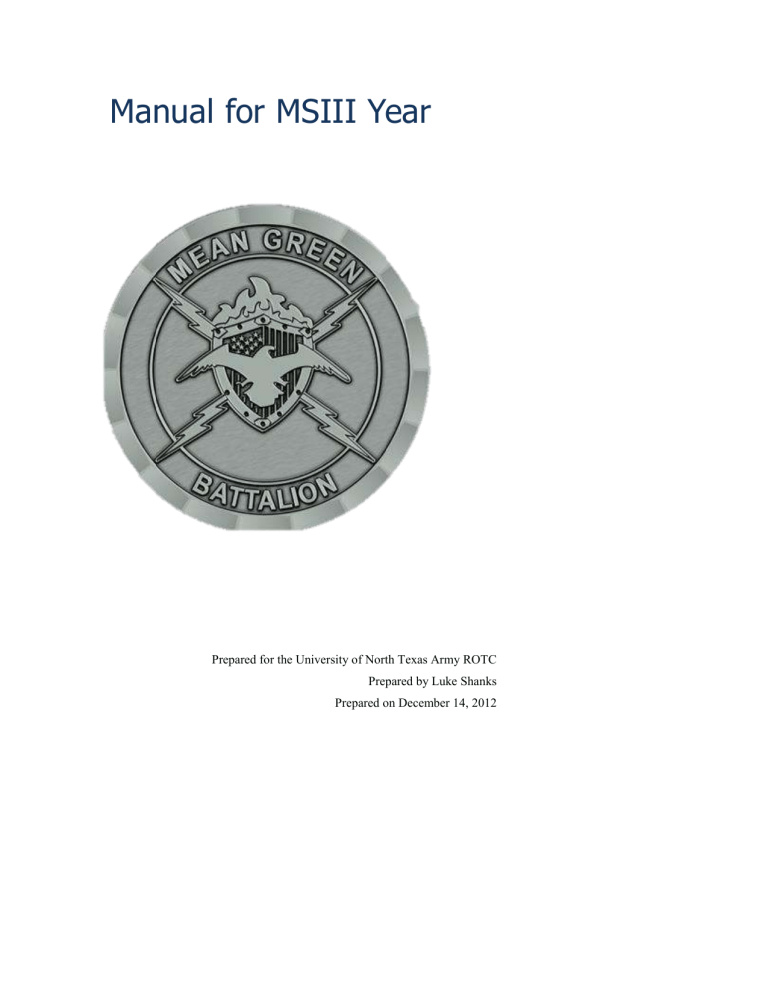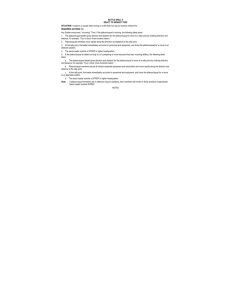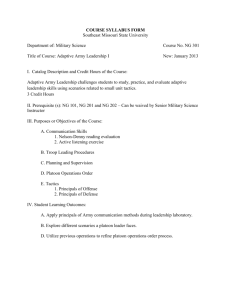File

Manual for MSIII Year
Prepared for the University of North Texas Army ROTC
Prepared by Luke Shanks
Prepared on December 14, 2012
Manual for MSIII Year
Table of Contents
Contents
Introduction to MSIII Year Manual ............................................................ 5
Standards for Physical Training .................................................................. 7
3
Manual for MSIII Year
Introduction to MSIII Year Manual
The manual will go into detail on the general tasks expected of an
MSIII. The manual will cover standards for physical training, lab, and special events. The manual will discuss implied tasks while in the garrison and field environment.
Figure 1 - North Texas Detachment
5
Manual for MSIII Year
Standards for Physical Training
Figure 2 - Physical Training
Squad Leader: The squad leader arrives at PT ten minutes prior to the start (0550). The squad leader reports in to the platoon sergeant and receives any information or orders to issue out for the day. The squad leader is to take accountability of squad members and begin calling the cadets who are missing from formation to gain full accountability. The squad leader is to motivate squad members by name and correct as needed.
Platoon Sergeant: The platoon sergeant arrives at PT fifteen minutes prior to the start (0545). The platoon sergeant reports in to the first sergeant and receives any information or orders to issue out for the day. The platoon sergeant communicates with the squad leaders to receive full accountability before first formation. The platoon sergeant coordinates
7
Manual for MSIII Year with the platoon leader for all personnel concerns and tasks. The platoon sergeant orders the squad leaders to correct all errors in the platoon and make spot corrections as needed. The platoon sergeant is to ensure standards are met for all exercises being conducted.
First Sergeant: The first sergeant arrives at PT fifteen minutes prior to the start (0545). The first sergeant reports in to the company commander to receive any mission essential tasks or changes to the day’s plan. The first sergeant coordinates with the platoon sergeants on the mission for the day and issues any changes to the plan. The first sergeant is the liaison between the officers and enlisted during the day’s mission.
To accomplish the task as liaison, the first sergeant periodically checks in with the company commander for a status report on the training.
Platoon Leader: The platoon leader arrives at PT fifteen minutes prior to the start (0545). The platoon leader reports in to the company commander to receive all tasks for the welfare of the platoon. The platoon leader coordinates with the platoon sergeant on all tasks and concerns for the platoon. The platoon leader is to encourage and monitor the improvement of the platoon. The platoon leader encourages improvement by issuing incentives to the platoon. The platoon leader monitors improvement by recording APFT scores and attendance patterns. The platoon leader inspires others to do well in PT by setting the example.
Assistant Instructor: The assistant instructor arrives at PT thirty minutes prior to the start (0530). The assistant instructor reports in to the primary instructor for final rehearsals. The plan for the day is on a notecard to ensure the commanders’ intent is followed. The assistant instructor is to lead the exercises during the session. The assistant instructor must find a balance between supervising the session to ensure the work out is to standard and leading by example by performing the exercises.
Primary Instructor: The primary instructor arrives at PT thirty minutes prior to the start (0530). The primary instructor leads a final
rehearsal with the assistant instructors. The primary instructor reports in to the S-3 PT to receive any changes to the plan. The primary instructor coordinates movement of platoons and timed rotations. The primary instructor stays in communication with the S-3 PT to ensure all standards are met.
9
Manual for MSIII Year
Standards for Lab
Figure 3 - Individual Movement Tactic Training during Lab
Squad Leader: The squad leader arrives at Lab ten minutes prior to the start (0750). The squad leader reports in to the platoon sergeant and receives any information or orders to issue out for the day. The squad leader is to take accountability of squad members and begin calling the cadets who are missing from formation to gain full accountability. The squad leader commands their squad through all squad level challenges.
Platoon Sergeant: The platoon sergeant arrives at Lab fifteen minutes prior to the start (0745). The platoon sergeant reports in to the first sergeant and receives any information or orders to issue out for the day. The platoon sergeant communicates with the squad leaders to receive full accountability before first formation. The platoon sergeant coordinates
11
Manual for MSIII Year with the platoon leader for all personnel concerns and tasks. The platoon sergeant orders the squad leaders to correct all errors in the platoon and make spot corrections as needed. The platoon sergeant commands their platoon through all platoon level challenges.
First Sergeant: The first sergeant arrives at PT fifteen minutes prior to the start (0745). The first sergeant reports in to the company commander to receive any mission essential tasks or changes to the day’s plan. The first sergeant coordinates with the platoon sergeants on the mission for the day and issues any changes to the plan. The first sergeant is the liaison between the officers and enlisted during the day’s mission.
To accomplish the task as liaison, the first sergeant periodically checks in with the company commander for a status report on the training.
Platoon Leader: The platoon leader arrives at Lab fifteen minutes prior to the start (0745). The platoon leader reports in to the company commander to receive all tasks for the welfare of the platoon. The platoon leader coordinates with the platoon sergeant on all tasks and concerns for the platoon. The platoon leader is to encourage and monitor the improvement of the platoon. The platoon leader encourages improvement by issuing incentives to the platoon. The platoon leader monitors improvement by recording land navigation scores and attendance patterns.
The platoon leader inspires others to do well in Lab by setting the example.
Assistant Instructor: The assistant instructor arrives at Lab twenty minutes prior to the start (0740). The assistant instructor reports in to the primary instructor for final rehearsals. The plan for the day is on a notecard to ensure the commanders’ intent is followed. The assistant instructor is to lead the movements and training during the Lab. The movement is to the assembly area for squad tactics exercise or the assistant instructor is to direct the flow to each class.
Primary Instructor: The primary instructor arrives at Lab twenty minutes prior to the start (0740). The primary instructor leads a final rehearsal with the assistant instructors. The primary instructor reports in to
the S-3 Lab to receive any changes to the plan. The primary instructor coordinates movement of platoons and timed rotations. The primary instructor stays in communication with the S-3 Lab to ensure all standards will be met.
13
Manual for MSIII Year
Garrison Assessments
Figure 4 - Promotion Ceremony for MAJ Flake
Yellow Card: The yellow card is a self-assessment. The yellow card is written in the STAR format. The acronym stands for: Situation,
Task, Action, and Result. The situation is the title of the leadership position and number of cadets in charge of. The task is any direct or implied task. The action is anything done to complete the task. The result is the verifiable outcome of all actions toward the task. The yellow card is for the evaluator of the leadership position.
Blue Card: The blue card is the assessment of the cadet in the specified leadership position. The blue card is for the assessor to grade the
MSIII on observations and the yellow card. The blue card format is an action then the result. The grading system is: Exceeds standards (E),
Satisfactory (S), Needs improvement (N). There are 17 dimensional sections which lead to an overall assessment of performance. The assessor
15
Manual for MSIII Year counsels and offers feedback to the MSIII. The blue card is the main counseling form in ROTC.


